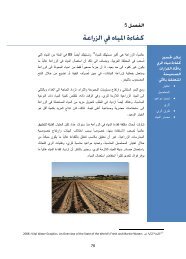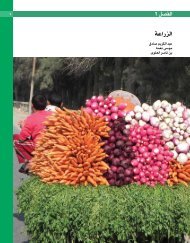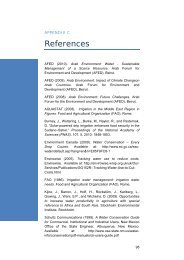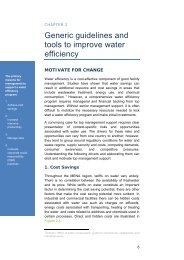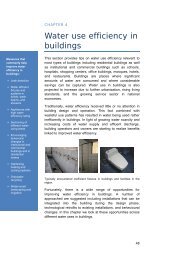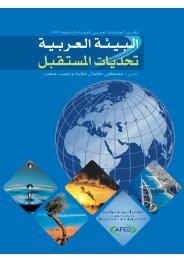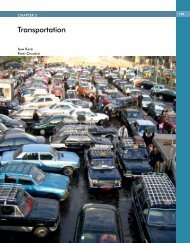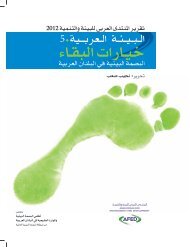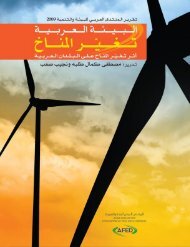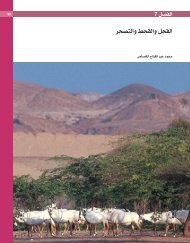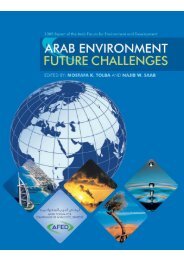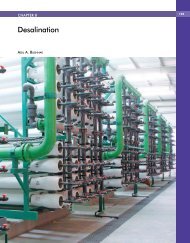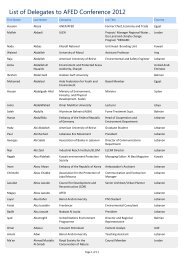Impact of Climate Change on Arab Countries - (IPCC) - Working ...
Impact of Climate Change on Arab Countries - (IPCC) - Working ...
Impact of Climate Change on Arab Countries - (IPCC) - Working ...
You also want an ePaper? Increase the reach of your titles
YUMPU automatically turns print PDFs into web optimized ePapers that Google loves.
102<br />
CHAPTER 8<br />
ECOSYSTEMS AND BIODIVERSITY<br />
I. OVERVIEW OF THE CURRENT STATUS<br />
OF BIODIVERSITY IN THE ARAB WORLD<br />
The <strong>Arab</strong> world houses a unique biological diversity<br />
in terms <str<strong>on</strong>g>of</str<strong>on</strong>g> species and ecosystems represented<br />
by arid, semi arid, and Mediterranean biomes<br />
(Figure 1). The reported number <str<strong>on</strong>g>of</str<strong>on</strong>g> species currently<br />
harboured in the <strong>Arab</strong> world is listed in<br />
floras, compendiums, and country reports (Table<br />
1). The richest countries documented in terms<br />
<str<strong>on</strong>g>of</str<strong>on</strong>g> plant diversity with more than 3000 species<br />
include Egypt, Leban<strong>on</strong>, Morocco, Syria,<br />
Algeria, Tunisia, and Somalia, while animal<br />
diversity is highest with more than 5000 species<br />
in Algeria, Leban<strong>on</strong>, Syria, and Tunisia (CBD<br />
nati<strong>on</strong>al reports). The density is estimated at<br />
1000-2000 plant species per 10,000 km 2 in<br />
Jordan, Leban<strong>on</strong>, Morocco, and Syria and less<br />
than a 1,000 per 10,000 km 2 for the remaining<br />
<strong>Arab</strong> countries. The density <str<strong>on</strong>g>of</str<strong>on</strong>g> mammal species<br />
ranges between 21-50 animal species per 10,000<br />
km 2 in Egypt, Iraq, Jordan, Morocco, Sudan,<br />
Syria, and Tunisia, with a high range <str<strong>on</strong>g>of</str<strong>on</strong>g> 51-100<br />
in Leban<strong>on</strong> and a range <str<strong>on</strong>g>of</str<strong>on</strong>g> less than 20 in the<br />
remaining countries (The Atlas <str<strong>on</strong>g>of</str<strong>on</strong>g> Endangered<br />
Species, 2005).<br />
Many species in the <strong>Arab</strong> world currently face<br />
major threats which will be augmented in the<br />
future due to the repercussi<strong>on</strong>s <str<strong>on</strong>g>of</str<strong>on</strong>g> climate change.<br />
With respect to terrestrial biodiversity and more<br />
specifically plant biodiversity, according to the<br />
2008 IUCN threat categories (Table 2), Yemen<br />
has the highest number <str<strong>on</strong>g>of</str<strong>on</strong>g> threatened species at<br />
159 while the remaining countries either did not<br />
indicate any data or range between 0 to 17<br />
species. With respect to animals, the countries<br />
with the highest number <str<strong>on</strong>g>of</str<strong>on</strong>g> threatened species<br />
according to the 2008 IUCN categories include<br />
Djibouti, Egypt, Jordan, Morocco, Saudi <strong>Arab</strong>ia,<br />
Somalia, Sudan, and Yemen which all have more<br />
than 80 threatened animal species, with a maximum<br />
<str<strong>on</strong>g>of</str<strong>on</strong>g> 108 species in Egypt. An overall status <str<strong>on</strong>g>of</str<strong>on</strong>g><br />
threatened species in the <strong>Arab</strong> world is summarized<br />
per specific tax<strong>on</strong>omic group in Table 3<br />
(IUCN, 2008).<br />
Marine biodiversity al<strong>on</strong>g the coasts <str<strong>on</strong>g>of</str<strong>on</strong>g> the <strong>Arab</strong><br />
world shows significant threat levels in selected<br />
areas such as the highly threatened dug<strong>on</strong>gs in<br />
Bahrain whose seagrass foraging grounds around<br />
the archipelago form the world’s sec<strong>on</strong>d largest<br />
dug<strong>on</strong>g aggregati<strong>on</strong> (a tightly linked group <str<strong>on</strong>g>of</str<strong>on</strong>g><br />
dug<strong>on</strong>gs, large marine herbivorous mammals,<br />
occupying the same area) after Australia. In<br />
FIGURE 1<br />
EXAMPLES OF SPECIFIC BIOMES IN THE ARAB WORLD<br />
Main biomes<br />
• Desert<br />
• Xeric shrubland<br />
• Semi desert<br />
• Mediterranean<br />
Sub-categories <str<strong>on</strong>g>of</str<strong>on</strong>g> biomes<br />
• Temperate broadleaf and mixed forest with temperate grasslands, savannas and shrubland<br />
in Oman, Jordan and Syria<br />
• Mediterranean forest, woodlands and scrub with scattered temperate c<strong>on</strong>ifer forest al<strong>on</strong>g the<br />
coastline <str<strong>on</strong>g>of</str<strong>on</strong>g> Morocco and Algeria<br />
• Tropical & subtropical grasslands savannas & in southern Mauritania and Sudan<br />
• Flooded grasslands& savannas in Egypt and Iraq<br />
Sources: SEDAC-Map client; Biomes and Ecosystems, 2008



